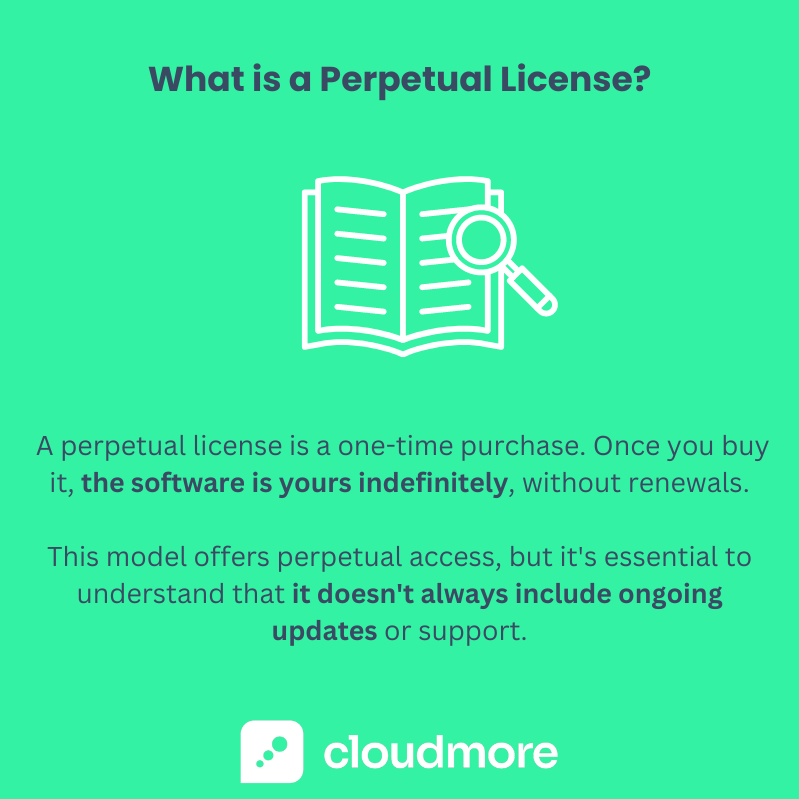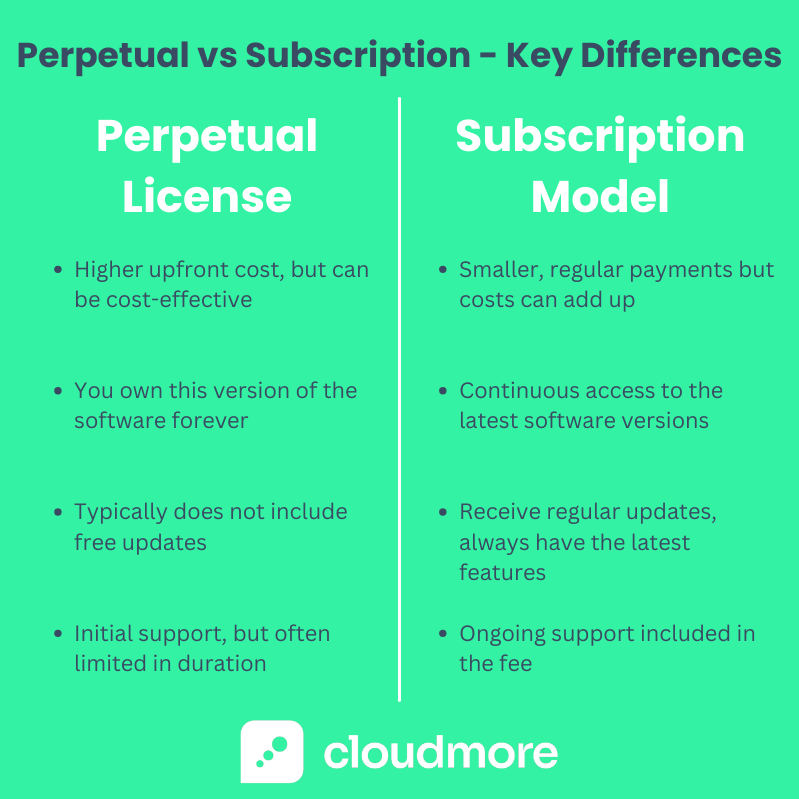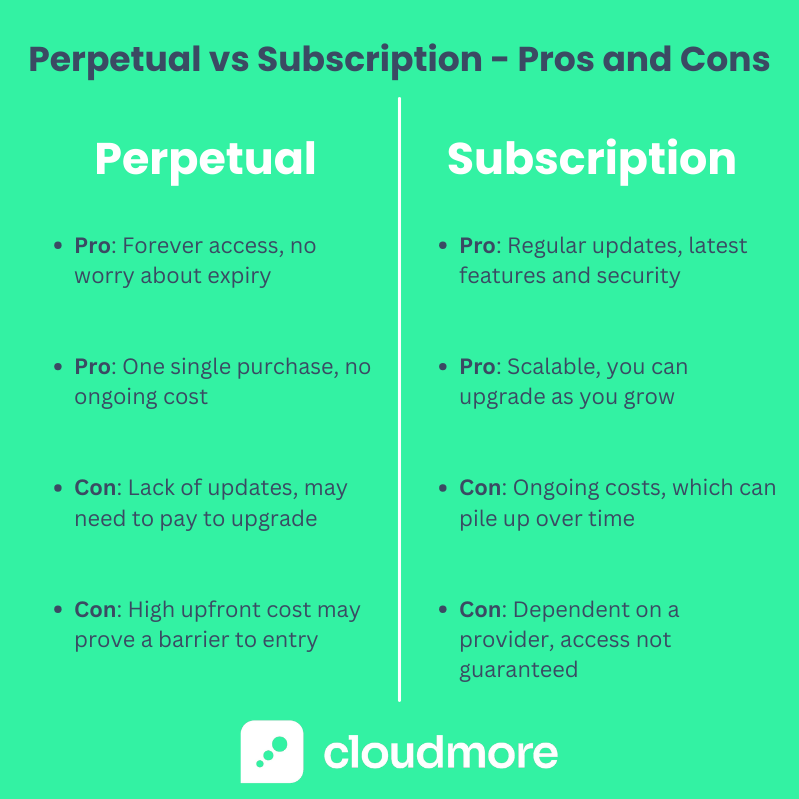Perpetual License vs Subscription Model: Key Differences and Examples
Almost every business on the planet uses some form of software. But how important is it to offer the right licensing model?
Crucial.
Whether you choose a perpetual license or a subscription model, it could be a game changer for your business.
This blog delves into these models' critical differences and impacts, addressing a key decision point in today's digital landscape.
The choice between a perpetual plan and a subscription model is not just about immediate costs or access to software. It's about aligning with long-term business strategies, adapting to technological advancements, and optimizing financial resources.
Get ready to equip yourself with the knowledge needed to navigate the complex world of software licensing.
Understanding the Basics
Understanding these models can significantly impact your software experience and costs, whether you're a business owner or a consumer. So, let's look at the basics about each of them.
Perpetual License: What is a Perpetual License?
A perpetual license is essentially a one-time purchase. Once you buy it, the software is yours indefinitely, without renewals. Think of it as owning a book - once bought, it's yours to keep forever.
This model offers perpetual access, but it's essential to understand that it doesn't always include ongoing updates or support.

For instance, the MATLAB perpetual license allows you to use the software indefinitely, but an additional fee may apply for upgrades. Another example is Adobe Acrobat Pro perpetual; it offers a one-off purchase, giving you permanent access to its features as they are at the time of purchase.
Subscription Model: The Basics of Software Subscriptions
In contrast, the subscription model is like renting a house. You gain access to the software for a recurring fee – usually monthly or annually.
This model often includes regular updates, support, and even additional features unavailable in perpetual licenses.

It's a flexible choice, offering scalability and lower upfront costs. Popular examples include Office 365 and the Adobe subscription model, where users pay an ongoing fee for access to the latest software versions and technical support.
Perpetual License vs Subscription Model
When deciding between a perpetual license and a subscription model, you choose between long-term ownership and flexible access. Let's dive into the key differences to help you make an informed decision.

Cost: Upfront vs Ongoing
Perpetual licenses often involve a higher upfront cost. You pay once, and the software is yours. In the long run, this can be cost-effective, but the initial investment is significant. For example, with a perpetual software license, such as Adobe Acrobat Pro, you pay a substantial amount initially but avoid recurring fees.
On the other hand, subscription models, like Office 365, typically have lower initial costs. You pay smaller, regular fees, spreading the cost over time. This can make cash flow easier but might lead to higher expenses in the long run.
Access: Ownership vs Rental
With perpetual licensing, you own the software version you purchase. You have perpetual access to it, but upgrades to newer versions usually require additional payment. For instance, if you opt for MATLAB's perpetual license, you can use that version indefinitely without further fees unless you upgrade.
Subscriptions, however, offer continuous access to the latest software versions if you pay the subscription fee. This ensures you have the most up-to-date tools, vital in fast-evolving tech environments.
Updates: Static vs Dynamic
Perpetual licenses typically do not include free updates. Once you buy a version, like the Filmora perpetual plan, you won't get future updates unless you pay extra. This might be suitable for software that doesn't evolve rapidly.
Subscription models excel here. Subscribers receive regular updates, ensuring they always have the latest features and security enhancements. This continuous evolution is a significant advantage for software that frequently updates, such as SaaS platforms.
Support: Limited vs Comprehensive
Support is another crucial factor. Perpetual licenses might offer initial support, but it's often limited in duration. For instance, with a perpetual software license, support may be available for the first year but would incur extra costs afterward.
Subscriptions usually come with ongoing support included in the fee. This means continuous access to help desks or technical support, an essential consideration if you rely heavily on the software for daily operations.
Advantages and Disadvantages
When deciding between a perpetual license and a subscription model, weighing their pros and cons is vital. Each model caters to different needs and scenarios, impacting your software experience and finances.

Pros and Cons of Perpetual Licenses
Perpetual licenses offer significant advantages but also have their drawbacks.
Advantages:
- Perpetual Access: Once you purchase, the software is yours. There's no worry about losing access due to subscription expiry.
- One-time Purchase: It involves an upfront cost but no recurring fees. This can be cost-effective in the long run, as seen in offerings like the Filmora perpetual plan.
Drawbacks:
- Lack of Regular Updates: Unlike subscriptions, updates aren't always included. You might need to pay extra for significant upgrades.
- Higher Upfront Cost: The initial investment is typically higher than a subscription, which might be a barrier for some users or small businesses.
Pros and Cons of Subscription Licenses
Subscription licenses have grown in popularity thanks to their unique set of benefits and some inherent challenges.
Advantages:
- Regular Updates: You get continuous access to the latest features and security patches, ensuring your software stays up-to-date.
- Lower Initial Cost: Lower upfront fees make it more accessible, especially for startups or individuals with budget constraints.
- Scalability: As your needs change, you can easily adjust your subscription level, making it a flexible option for growing businesses.
Drawbacks:
- Ongoing Costs: While the initial cost is lower, the recurring fees can add up over time, potentially surpassing the price of a perpetual license.
- Dependency on Provider: Your access is tied to the subscription. If the service is discontinued or your renewal fails, you lose access to the software.
Industry Examples and Case Studies
The transition from perpetual licensing to subscription models in the software industry is illustrated by several notable examples, reflecting the evolving preferences and requirements of both businesses and individual consumers.
Microsoft's Transition
A vital example of this shift is Microsoft. The company has been transitioning from offering perpetual software licenses to subscription-based models. Traditionally, Microsoft offered a perpetual license for their Office software, which required a one-time purchase for indefinite use.
However, with the rise of cloud computing and Software-as-a-Service (SaaS) offerings, Microsoft introduced Office 365, a subscription-based service. This model allows businesses to pay a recurring fee for the latest software versions, offering continuous access to updates and new features. The move to a subscription model represents a significant change from the traditional perpetual license, where users owned the software after a single upfront payment.
Adobe's Success in Subscription-Based Model
Adobe is another prime example, particularly notable for its successful transition to a subscription-based model. Initially, Adobe experienced a revenue loss at the start of its SaaS transition, but it has since become a leading example of successful implementation of subscription-based products.
This shift from perpetual licenses to a recurring subscription model was a strategic move that allowed Adobe to provide continuous updates and features to its users, thereby enhancing user experience and software value over time.
The Retail Industry Example
Retail offers a practical illustration of the subscription model's advantages. For instance, a retail store might need additional Microsoft licenses for seasonal employees during the holiday season.
With a subscription model, the store can pay for a one-month subscription and stop the service once the season ends, demonstrating the flexibility and cost-effectiveness of the model, especially for short-term or fluctuating needs.
Impact on Revenue and Business Goals
The shift from perpetual to subscription licensing affects revenue and business operations. Subscription licensing allows for flexible pricing, potentially reaching a broader customer base with varying budgets. It also helps increase sales conversion rates by lowering the barrier to entry compared to the high upfront cost of perpetual licenses.
Furthermore, the subscription model provides ongoing value to customers through regular updates and new features, enhancing the user experience and potentially leading to longer customer retention. Another critical aspect of the subscription model is its ability to provide forecasting data, helping businesses plan more strategically and establish predictable recurring revenue.
Financial Implications
When considering software licensing models, it's essential to understand their financial implications. This knowledge will guide your strategic decisions, impacting immediate costs and long-term financial planning.
Revenue Recognition and Accounting
In the realm of software licenses, revenue recognition plays a pivotal role. The standards guiding revenue recognition have evolved, particularly with the ASC 606 revenue recognition standard. This standard applies across all industries, including software and SaaS. It places a core emphasis on recognizing revenue that reflects the transfer of goods or services to customers in exchange for expected consideration.
Perpetual Licensing: In perpetual licensing, revenue recognition is typically straightforward. Revenue for perpetual and time-based licenses can be recognized when licenses are delivered, assuming an arrangement with the customer exists, the collection is probable, and the price can be determined.
Subscription-Based Models: The ASC 606 standard has introduced some complexities for SaaS and subscription models. These include determining standalone selling prices of software licenses in an arrangement, identifying performance obligations in hybrid cloud-based arrangements, and capitalizing certain contract acquisition costs—the standard's significant impact on revenue and cost recognition for technology entities like software and SaaS companies. There's a shift from recognizing revenue upfront (as in perpetual licenses) to recognizing it over the subscription period, which aligns with the ongoing delivery of software services.
Cost Analysis for Businesses
When it comes to business cost analysis, understanding each model's long-term financial implications is crucial.
Perpetual Licensing: This model involves a higher upfront cost but eliminates ongoing fees, making it cost-effective over a long period. It is often treated as a capital expense, like buying a physical asset.
Subscription Model: This model offers a lower initial cost but involves recurring fees, which can add up over time. It shifts the expense from capital to operational, allowing for better alignment with actual software usage and easier budgeting.
The choice between perpetual and subscription models has significant financial implications. Perpetual licensing tends to be more straightforward regarding revenue recognition and might offer long-term savings despite higher initial costs.
In contrast, while providing lower upfront costs, the subscription model involves complexities in revenue recognition and ongoing expenses that can accumulate over time.
Key Takeaways about Perpetual Licenses and Subscription Models
We've uncovered several key insights exploring the differences between perpetual licenses and subscription models. Let's summarize them to help you make an informed decision:
- Long-term Costs vs. Initial Investment: Perpetual licenses often require a higher upfront investment but may lead to lower long-term costs. In contrast, subscription models generally have lower initial costs but involve ongoing payments.
- Access to Updates and Support: Subscription models typically ensure you always have the latest software updates and ongoing support. With perpetual licenses, updates might require additional purchases, and support could be limited over time.
- Flexibility and Scalability: Subscription licenses offer greater flexibility, particularly for businesses with fluctuating workforce sizes. Perpetual licenses, however, provide stability and long-term access without continuous payments.
- Revenue Recognition and Accounting: Understanding how each model impacts your accounting practices is vital. The subscription model shifts revenue recognition over the subscription period, while perpetual licenses allow immediate recognition upon delivery.
- Industry Trends and Preferences: There is a significant shift towards subscription models in the software industry, driven by the flexibility and continuous updates they offer.
- Making the Right Choice: Choosing the suitable model depends on various factors, including your business size, budget constraints, and how critical software updates are to your operations.
- Software Licensing Management: Efficient management of whichever license model you choose is crucial to ensure compliance and optimize software usage.
To delve deeper into these topics or explore specific software licensing options, don't hesitate to contact industry experts or consult detailed guides and case studies. Whether it's perpetual or subscription licensing, making the right choice can significantly impact your business's efficiency, budget, and overall success.
Share this
You May Also Like
These Related Stories

Guide to Usage-Based vs. Subscription-Based Pricing in B2B Models

How Robust is the Subscription-Based Business Model Really?



